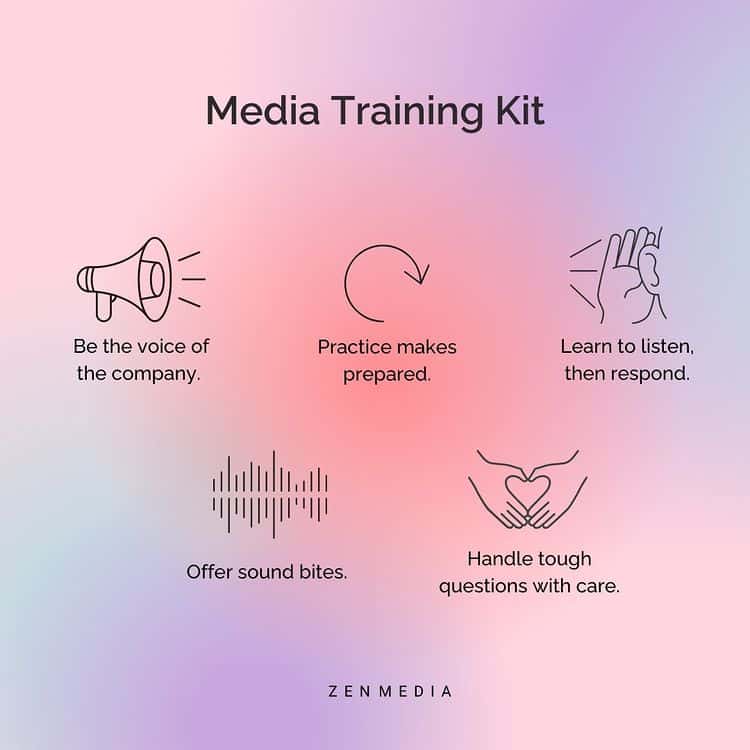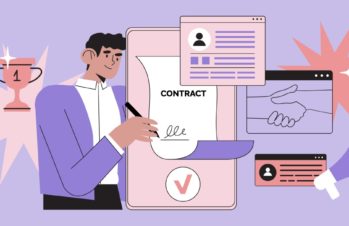You’re ready to talk to that reporter and give the world your expert opinion.
But wait! Have you taken any media training courses? Whether it’s news, social media, or live streaming, a lot goes into making an appearance that makes you look good.
Enter media training. In today’s fast-paced and ever-changing media landscape, it is crucial for individuals and organizations to be equipped with the skills and knowledge needed to navigate these interactions successfully. The best practices for media training can vary depending on the industry, organization and the specific needs of the individual, however, there are some general principles that apply across the board. In this post we will explore some of the best practices for media training that can help you effectively communicate with the media and the public.
What is Media Training?
Media training is the process of preparing individuals or organizations to effectively communicate with the media and the public. Typically this includes instruction on how to handle various types of media encounters, such as live television or radio interviews, print or online news articles, and social media interactions. Trainees may learn how to control the message and stay on topic during an interview, how to anticipate and respond to difficult questions, and how to handle unexpected turns in the conversation. They may also learn how to use body language, tone of voice, and other nonverbal cues to convey confidence and credibility.
In addition to training on how to handle specific media encounters, trainees may also receive instruction on how to craft and deliver effective speeches, presentations, and press releases. This may include learning how to write in a clear and concise manner, how to use persuasive language and storytelling techniques, and how to design effective visual aids.
Why is Media Training for Executives Important?
In today’s fast-paced and hyper-connected business world, media exposure can be a make-or-break factor for executives and their companies. As an executive, you may be called upon to represent your organization in interviews, press conferences, or other media events, where your words and actions can have a significant impact on your brand’s reputation and bottom line. That’s why media training has become a critical skill set for modern executives who want to succeed in the public eye.
In this blog, we will share some essential media training tips and strategies that can help you prepare for any media situation, communicate your message effectively, and build a positive public image for your B2B brand. Whether you’re a seasoned executive or a newcomer to the media game, these media training tips will help you navigate the media landscape with confidence and skill.
15 Media Training Tips for Success

1. Present yourself as the voice of the company.
The public image of your company is projected by your spokesperson (you!), so you have the single largest impact on whether a feature is written, a podcast episode runs, or a webinar is successful. If you’re doing your job right, you’ll give journalists and hosts all the information they need to create well-rounded content and give their audiences plenty of quotes and context.
Clearly emphasizing your key messages during each media appearance is the key to a consistent brand image. We’ll talk about the importance of sound bites later, but knowing your key messages—three concise points does the trick—means you can bring any answer you give back to one of those points.
Have a positive attitude toward the interview (and all interactions with reporters). Journalists generally don’t get paid enough for how much work they do, so they won’t put up with sour or unenthusiastic interviewees.
Plus, respect goes both ways: respect begets respect.
Politeness doesn’t guarantee you a feature or an invite back to a show, but it does ensure that people won’t think, “Oh no, not them again” when they hear your name.
Related reading: PR Isn’t a Nice-to-Have, It’s a Must Have
2. Know your message
Before any media encounter, be clear on the key message you want to convey. This will help you stay on topic and control the conversation. Knowing your message will also help you to anticipate questions, so that you can stay focused on the message you want to deliver. It’s important to remember that the media is not always interested in the same thing that you are, so it’s essential to be clear and concise when communicating your message.
3. Practice makes prepared.
What’s the best way to practice for an interview? In your own words!
You might think: “But I don’t want to make any mistakes!” or “What if I forget what I’m supposed to say?” Well, that’s why you need a personal interview prep document.
This document should include everything you want to say, as well as some questions that might be asked and how you would answer them. It can also include notes about the interviewer or ways to make the conversation more personal.
The key is showing your interviewer that you are invested in building a mutually beneficial relationship with them—not just looking for quick press.
When you practice interviewing, don’t try to memorize everything. Instead, establish a few key messages and be prepared to speak about them in various contexts. This can help alleviate the fear of “saying the wrong thing” and also help you sound more natural because you won’t be repeating notes.
4. Learn to listen, then respond.
Resist the temptation to interrupt. Instead, let the reporter finish their question before you begin speaking, especially if it’s a long question with many parts (you don’t want to get lost in your answer). Mentally note points you’d like to make after the reporter finishes talking so you can address them in your response if necessary. This will also help ensure that everyone’s on the same page about what was just said during your conversation—and it builds trust between you and the interviewer by showing that you are really listening and thinking about the questions they are posing.
5. Keep it simple
Speak in plain language and avoid jargon or technical terms that may confuse your audience. Keep in mind that the media and public are not experts in your field, so it’s essential to explain things in a way that’s easy to understand. Avoid using complex language or technical terms that may be unfamiliar to your audience.
6. Offer sound bites.
Sound bites are short, declarative sentences that convey your message and can stand alone as a quote. They use active verbs to illustrate your points and make them memorable. These are the most important points you want the public to read or hear, so think them through and make sure they really say something and aren’t just buzzwords.
To help you deliver your message as effectively as possible, avoid filler words like “um,” “like,” or “you know.” Instead, use active verbs such as “say,” “think,” and “believe.” This will keep the conversation flowing smoothly from topic to topic without delay.
Don’t be afraid to use metaphors and analogies to add color and depth to your message. A good metaphor can help tie complex ideas into something easily digestible by an audience unfamiliar with your industry or area of expertise. Metaphors also help illustrate key points by making them more memorable than simply stating facts. And they’re fun!
Think about Chevy’s Like a Rock campaign, which illustrated the resilience of their vehicles in a concise and engaging way.
Related reading: Why Every PR Campaign Needs Social Media Marketing
How can your brand’s top feature or the way it solves a pain point be summed up in a brief and creative way?
It’s important not to overdo it and over complicate your message or to be silly to the degree of immature—your audience won’t appreciate being talked down to. And remember that humor is subjective!
Lastly, keep things simple whenever possible by avoiding over-answering questions or giving too much detail about every aspect of what it takes for something to go from idea generation to concept development all the way through production until launch day itself…or risk being quoted out of context later on down the road.
7. Handle tough questions with care.
If a reporter asks you a question that’s too difficult to answer, don’t be afraid to say, “I don’t know.” The best way to respond when asked about something that isn’t your area of expertise is to simply say, “I’m not an expert in this area, but I can find out for you by [insert time frame].” Then do so!
But whatever you do, don’t get defensive. It’s fine if you disagree with the interviewer’s line of questioning or reasoning, but avoid getting into an argument or debate unless it serves your purpose (which is unlikely).
Additionally, avoid answering hypothetical questions. You don’t need to be able to predict the future to have an opinion on something—instead, use your experience and knowledge base as a starting point for expressing what it means for your company/organization/idea/etc., and why it matters today.
8. Don’t lead with sales-speak or jargon.
Don’t speak in abbreviations, acronyms, or industry tech jargon. No matter how well you communicate, don’t assume that a reporter will understand what you mean by “responsive design” or “omnichannel marketing.” If they don’t know the lingo, they won’t get what you’re saying, and your message will be lost in translation. Instead, tailor your use of industry-specific language to the reporter’s understanding of your business and its benefits—and if they don’t understand, either explain more clearly or change course altogether!
Instead of salesy language and jargon, lead with compelling stories and statistics that support your key messages. Make what you say memorable.
Related reading: 5 PR Tips to Put Your Tech Company on the Radar
9. Establish a rapport with your interviewer.
Establishing a rapport with your interviewer can happen in a variety of ways. If you’re lucky, maybe you’ve already spoken with them and have a sense of their communication style. But, you’ll most likely meet them for the first time at the interview or event.
As you would in any new introduction, maintain eye contact; it shows that you are engaged with what they are saying and interested in their questions. Take the time to understand what the interviewer is really interested in learning from you, and provide genuine information relative to the reporter’s interest.
Finally, do not speak off the record. Many media-savvy people use off-the-record or on-background as a tool to enhance their relationships and credibility with the news media. However, it’s important to know the rules because no matter how media-savvy you are, the reporter always has the upper hand when you make an off-the-record statement. The easiest way to solve this problem is by not going off the record.
10. Develop a Strong Opening Statement
Your opening statement sets the tone for the rest of your communication. It should be clear, concise, and grab your audience’s attention. Your opening statement should also communicate your key messages and set the agenda for the rest of your communication.

11. Read your audience’s body language.
If the reporter looks or sounds confused, ask if there’s something you need to clarify. Sometimes, they’re trying to collect their thoughts about how they plan to write the story. Or they don’t understand what you’ve said. Checking ensures your messages are properly communicated and received.
For media appearances with a live audience, it’s also important to gauge the audience’s engagement. Are they interested and understanding what you are saying? Or are they bored, confused, and waiting for the next guest?
12. Embrace Silence
Silence can be a powerful tool in effective communication. Learn to embrace silence during your media training and practice remaining silent to allow your audience time to absorb and reflect on your message. Silence can also be used to emphasize important points and create a more engaging experience during your media interview.
13. Don’t get flustered if the conversation takes a wrong turn.
When speaking to the media, it’s easy to get lost in the moment as a reporter asks question after question. After all, they’re asking you questions about yourself and your company—why wouldn’t you want to answer them? But remember that these folks have their own agenda, too: They want great quotes and information for their story.
That means if they ask you a question that doesn’t quite make sense or feels like it’s off-topic, don’t take it personally. They may be looking for something specific, or they may simply have a different way of interpreting what happened than how your team interprets a situation; either way, there’s no reason for anyone involved with the interview process (you included) to get flustered by this type of misunderstanding.
If you don’t understand something or want more information about what was asked, request clarification as needed (e.g., ‘I don’t understand what you mean by “x”? Could you explain it in another way?’). Also, remember that sometimes reporters may ask questions from different angles than you are expecting; this is part of the process so try not to become defensive even if the reporter is on the offense.
Take your time before responding to questions, whether thinking through what you want to say or simply considering how best to answer it. And finally, reserve the right to say ‘no comment’ or defer your answer until you have more information (e.g., ‘Let me get back to you on that later today).
14. Repeat, repeat, repeat your key messages.
Effective communicators repeat the same messages over and over again. This is simple: it ensures consistency, focuses on the points most important to your brand, and helps keep an interview on track. Repetition gives you the best opportunity to drive home your most important message(s).
As we mentioned earlier, it is crucial to identify the key message(s) you want to be communicated and plan your sound bites around them. This practice will also help ensure that when faced with unexpected questions in a live interview (which happens often), you can give concise answers without losing sight of how they relate back to these central themes—and how they fit into broader narratives you’re telling about your brand.
At the end of an event or interview, if the reporter or host asks if there’s ‘anything else you’d like to mention,’ use it as an opportunity to end the conversation with your key messages.
15. Follow up after the interview
Following up after the interview can help to to keep you top of mind with the interviewer and create a more positive and productive experience for the reporter and your organization. Following up shows that you value the time and effort of the interviewer and that you are committed to building a positive relationship with them.
When following up, you can send a brief email or note thanking the interviewer for their time and expressing your appreciation for the opportunity to speak with them. You can also use this opportunity to reinforce your key messages and to provide any additional information that may be helpful.

16. Be prepared for a crisis
Have a plan in place for dealing with unexpected or negative events that may damage your organization’s reputation. This includes having a designated crisis management team, and being prepared to release statements or hold press conferences on short notice. It also includes having a plan in place for dealing with negative comments or criticism on social media.
Related Reading: 13 Ways to Handle a PR Crisis
17. Keep learning
Media training is an ongoing process. Keep learning and adapting to the ever-changing media landscape. The media landscape is constantly changing, so it’s essential to stay informed and to keep learning. This includes keeping up to date with the latest trends and developments, as well as seeking out new training opportunities.
After a media encounter, seek feedback from a trainer or experienced professional to understand how you can improve. Feedback can help you to identify areas where you need to improve and to gain a better understanding of how you’re perceived by others
18. Smile and have fun!
Smiling helps you relax, so if you’re nervous about an interview, put on a happy face. It’s not only good for your nerves but also good for the reporter to see you having fun with the process. You’ll look more confident and likable when you’re smiling.
The more open and comfortable both parties feel during an interview process, the easier it will be for everyone involved—and nothing makes people more uncomfortable than an awkward silence where there should have been some laughter instead!
While media appearances are big opportunities for brands, you have to enjoy what you’re doing; otherwise, what’s the point?
Final Thoughts
Remember that media training is a process and not an event. You won’t transform overnight into the perfect spokesperson. But with practice and patience, you can improve your skills and become more comfortable speaking in front of an audience or camera.
Don’t forget to smile, be authentic, and have fun as you perfect your public speaking game! If you’d like to increase your company’s media appearance and be trained on media etiquette by some of the best in the business, reach out.







